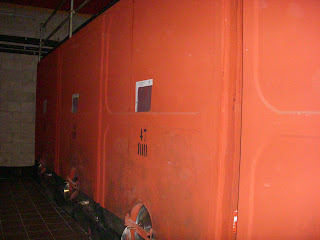It has been owned by the Di Napoli Rampolla family since 1739
They have planted their vineyards extremely densely at 8000 plants per hectar.
















This is our idea of quality: 5,200 plants per hectare, thinning out and harvesting by hand, a maximum production of 60 quintals per hectare"
We tasted:
2003 Vino Nobile di Montepulciano DOCG RISERVA
Grapes used: Prugnolo Gentile 90%, Merlot and Cabernet Sauvignon 10%.
Vinification: hand-picked in perforated boxes, destemming, fermentation in stainless steel tanks at controlled temperature (max. 28° C), maceration for 20 days with repeated remixing, racked off the lees and pressed gently with pneumatic bladder presses. Malolactic fermentation in tanks at 20° C, transferred into barrels.
Alcohol content: 13.5% vol.
Refining/maturing: 24 months in Allier barriques, then 12 months in bottle.
2004 Vino Nobile di Montepulciano DOCG
Grapes used: Prugnolo Gentile 90%, Merlot and Cabernet Sauvignon 10%.
Vinification: hand-picked in perforated boxes, destemming, fermentation in stainless steel tanks at controlled temperature (max. 28° C), maceration for 20 days with repeated remixing, racked off the lees and pressed gently with pneumatic bladder presses. Malolactic fermentation in tanks at 20° C, transferred into barrels.
Alcohol content: 13.5% vol.
Refining/maturing: 18 months in Allier oak cacks, then 10 months in bottle.
Corte alla Flora - Rosso Toscano IGT Super Tuscan
Extremely new world!
Grapes used: Cabernet Sauvignon 50%, Merlot 30%, Prugnolo Gentile 20%.
Vinification: hand-picked with selection of the grapes, destemming, fermentation in stainless steel tanks at controlled temperature (max 28°C), maceration from 15 (Prugnolo Gentile) to 30 days (Cabernet Sauvignon), racked off the lees and pressed gently. The wine is made just by the grapes of the first phase of the wine-making. Malolactic fermentation in tanks.
Alcohol content: 14% vol.
Refining/maturing: 12 months in Allier barriques, then 12 months in bottle.
Giuggiolo - Red Wine IGT Toscana
Grapes used: Prugnolo Gentile 100%.
Vinification: hand-picked in perforated boxes, destemming, fermentation in stainless steel tanks at controlled temperature (max. 28° C), maceration for 10 days with repeated remixing, racked off the lees and pressed gently with pneumatic bladder presses. Malolactic fermentation in tanks at 20° C, transferred into oak casks.
Refining/maturing: 6 months in oak casks, then 6 months in bottle.
Technical card
Grapes used: Chardonnay and Sauvignon Blanc.
Light, Fresh, and Fruity












 and Joe Best
and Joe Best






